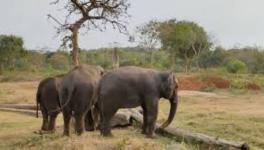Uttarakhand: Shrinking Elephant Corridors -- Nowhere to go!

Image Courtesy: Wikimedia Commons
Dr Bivash Pandav, a biologist with the Wildlife Institute of India has extensively researched a wide range of animals, such as tigers, elephants, swamp deer and Olive Ridley turtles. He has studied tigers across the Terai landscape and has helmed long-term programmes to monitor tigers and prey populations in the Rajaji Tiger Reserve in Uttarakhand. Elephants also form an integral part of the Terai landscape, and since they require more space than other animals, their survival is a matter of concern for environmentalists. Edited excerpts from an interview:
Rashme Sehgal: How many elephant corridors were being actively used by elephants in and around Uttarakhand/Uttar Pradesh five decades ago? How many have become non-functional?
Bivash Pandav: Five decades ago, the Terai Arc Landscape in Uttarakhand and UP was much more contiguous and was actively used by elephants as well as a host of other animals, including tigers. In 2003, Dr. A.J.T. Johnsingh and a team from the Wildlife Institute of India carried out an intensive survey of the landscape and identified 13 wildlife corridors across Uttarakhand and UP. This survey report was published in 2004. Of these 13 corridors identified, Gola River corridor at Lalkuan near Haldwani town has been completely lost and has become totally non-functional. Besides, widening of the national highway without any mitigation measures near Khatima town has posed a big question mark on the functionality of the Kilpura-Khatima-Surai corridor, on the eastern most part of Uttarakhand.
RS: Shrinking corridors have seen an acceleration in man-animal conflict? Their large-scale movement is closely associated with their search for food and water. Hindrances in their path result in aggressive behaviour.
BP: Yes, this is very true and is happening in Uttarakhand. The loss of Gola River corridor near Haldwani has restricted movement of elephants across the landscape and has resulted in an increased human-elephant conflict in the Terai Central Forest division of Uttarakhand.
RS: What areas does the Terai Central Forest Division cover? How many elephants are moving about in this area? How do they respond to conflict with humans? How else does this affect their behaviour?
BP: In North India, the Terai spreads from the Yamuna River eastward across Haryana, Uttarakhand, Uttar Pradesh up to Bihar. But Uttarakhand falls under the Terai West Forest Division. Because elephants are not able to negotiate the Gola River corridor, they are venturing into other areas that are full of human habitations, thus resulting in increased negative interaction with humans.
RS: In the constituency breakup being prepared for the Lok Sabha elections, man-animal conflict seems to be a recurring problem across Uttarakhand. Your comments.
BP: Human-wildlife conflict in Uttarakhand is on the rise and will increase in future. The forested habitats in the foothill areas are inhabited by a high density of wild animals. Incidentally, the plains of Uttarakhand are also rapidly getting urbanised, giving rise to increased interface with wild animals. Massive townships have mushroomed along the southern boundary of Rajaji Tiger Reserve over the past two decades. The township of Kotdwar has spread along the southern boundary of Lansdowne forest division. Urbanisation has rapidly increased along the southern and eastern boundary of Corbett Tiger Reserve.
While urbanisation has spread everywhere, the habitats of wild animals has not increased an inch. The hard boundary between the wilderness and urban habitats will only witness more and more conflict scenarios in days, months and years to come.
RS: The biggest problem elephants and wildlife is facing are the increasing number of linear infrastructure projects across the state and country. This has resulted in the shrinking of forest spaces as also in dividing forests, forcing elephants to travel greater distances in search of food and water. How can this problem be dealt with?
BP: In many instances, these linear infrastructures are inevitable. However, most of these linear infrastructures can be made wildlife-friendly. Construction of animal underpasses in case of road expansion (flyover for vehicles) at critical wildlife crossings have been found to be very useful for providing safe passage to wild animals. The National Highway Authority of India (NHAI) is increasingly becoming sensitive about these issues. Animal underpasses have been built in critical corridors like the one at Chilla-Motichur and Kansrau-Barkot. They are currently under construction in Rasiabad Range of Haridwar forest division. The elevated road between Ganeshpur and Mohand, currently under construction will greatly facilitate movement of wild animals between Ganga and Yamuna.
Similarly, passages can be provided to wild animals along railway tracks. Canals can be made wildlife-friendly by removing the concrete embankments.
RS: For the past three years, a herd of elephants has been stuck in the Timli area near Paonta Sahib on Uttarakhand’s border with Himachal Pradesh. The large number of roads being built or widened around Timli have made it impossible for this herd to move. The then Mussoorie District Forest Officer, Ashutosh Singh, when asked, said, “They [the elephants] will have to be translocated from there. Some alternative plan has to be worked out for this herd.” Nothing has been worked out so far. Your comments.
BP: All these issues can be sorted out. Both the forest department as well as the development agencies should seek right advice from experts and the different concerned agencies. If appropriate mitigation measures are provided for safe passage of animals at the right places, all these issues can be addressed.
RS: Experts like you suggest the building of more underpasses and overpasses. But does this solve the problem of easy access to food and water sources? Take the example of the Delhi-Dehradun Expressway being built along a huge swathe of the Rajaji National Park, whereas the underpass covers a much smaller distance. The same thing has happened in the 3-km-long underpass for elephants in the Haridwar Forest Division Road. Are we resorting to token solutions whereas the attempt should be to curb infrastructure construction around forest reserves?
BP: No, these are not token solutions. These are rather long-term solutions to maintain the permeability of the landscape. These animal underpasses are being constructed after proper studies, following due protocols. Considerable efforts have gone in while conceptualising these animal passages. Being involved in these two cases in person, I can certainly vouch for these animal passages. Well, disturbance at this point of time may appear very high due to ongoing construction activities. However, once constructed, these will be very effective in providing safe passage to wild animals.
RS: In the case of the Dehra Dun Expressway, bureaucrats are aware that for over three months, the Mohand Rao river that meets Sonali and Chibber rivers, overflows. This also creates problems for the animals. This should also have been factored in when the expressway plan was mooted. Your comments.
BP: Rivers are not a problem for animal crossing. All wild animals are capable swimmers and are known to negotiate Ganga River in full spate. So, there are absolutely no issues as far as river crossing in monsoon is concerned.
RS: Are you saying that elephants, tigers and other large mammals can swim across the Ganga in full spate without getting swept away?
BP: Yes, they have the ability to swim against strong current. Rivers are not a barrier for these animals.
RS: Shrinking corridors affect animal migratory patterns, which have been found to affect their breeding. Your view?
BP: The decline of tigers in the western part of Rajaji, for that matter in the entire stretch of the forest between Ganga and Yamuna and beyond Yamuna, is a classic example. Lack of functionality of Chilla-Motichur corridor has resulted in near extinction of tigers in the forested tract west of river Ganga.
RS: But what about elephants and their breeding behaviour? Can they breed in shrinking habitats?
BP: It will certainly affect elephants. Fortunately, older bulls are still present in this area and they keep moving on both sides of the Ganga, thereby facilitating genetic exchange. The elephant herds are not moving across Ganga. Once these older bulls disappear from this area, the younger bulls will have no idea on how to negotiate through this narrow corridor. The older bulls know the corridor because as young ones they once crossed the river and frequented both parts of Rajaji with their maternal herds. Now that female herds are not moving across the river and once the older bulls die out, the impact will be seen on the elephant population.
RS: The Chilla, Motichur and Shyampur forests have been found to be subjected to intense anthropogenic pressures, such as livestock grazing, fuelwood collection and habitat fragmentation. How can this be reversed? There are 800 Gujjar families settled in the Shayampur Range in the Haridwar division of Rajaji park, who were given only grazing rights. In 2004, the government had a successful rehabilitation policy but it has stopped under the current BJP regime. As a result, thousands of water buffaloes bathe and urinate in the flowing rivers of the reserve. Sadly, the rivers flowing through Dehradun are now full of sewage, and hence elephants need to move greater distances to find clean water.
BP: Making the forest inviolate through voluntary relocation of Gujjar settlements and providing the Gujjars a better livelihood opportunity is the way forward. The government of Uttarakhand has shown tremendous commitment to protect its wildlife through voluntary relocation of Gujjar settlements in Rajaji and Corbett national parks. This effort needs to be continued in other critical wildlife areas beyond these two protected areas.
RS: Forest officers are aware of these problems but seem to be helpless in the face of increasing political pressure. Your view?
BP: There are ways and means of solving every problem in this world. Political pressure was always there and will always be there. A pragmatic approach, a positive attitude, a thorough understanding of the ground situation and a clear idea about the future of these forests are absolutely essential for any forest officer to help save this area.
RS: What is the present population of elephants in Uttarakhand as compared with five decades ago?
BP: All I can say is that the elephant population in Uttarakhand is still very healthy. The human-elephant conflict situation in the state is far less compared with other high-conflict zones. A lot of effort has gone in consolidating wildlife habitats in Rajaji and Corbett. A little more effort in consolidating other key areas ,such as parts of Haridwar, Lansdowne and buffer areas of Corbett Tiger Reserve, will go a long way in securing the future of elephants in Uttarakhand.
Besides, a master plan for all the wildlife corridors in the state is a must.
Uttarakhand must designate all its wildlife corridors and give them a legal status, if not protected areas, they should at least be declared as eco-sensitive zones.
RS: What is your opinion on elephants being tranquilised and then relocated. Is this a solution to the problem of man-animal conflict?
BP: This is being done in Hassan district in Karnataka and has not helped reduce the problem. Addressing the root cause of the problem is much more important than translocating problem animals. Translocation is a short-term solution. It doesn’t help in the long run.
RS: Why have elephant reserves not been given legal sanctity in the way that tiger reserves have, given our dwindling elephant population? Metal spikes are being installed to hinder elephant movement. Your comments.
BP: The concept of elephant reserve is more from that of a landscape management perspective. The idea of an elephant reserve is to recognise the critical needs of elephants within a landscape and to maintain the integrity of the elephant landscape. It’s difficult to declare the entire landscape as a protected area and it’s not possible all the time. However, critical needs of the elephants, such as corridors, mitigation measures for linear infrastructure and critical habitat requirements of elephants, can be taken care of within an elephant reserve.
RS: What are your views on the dumping of urban waste in forests forcing elephants and other wild animals to forage garbage dumps?
BP: Utter stupidity. Absolutely ridiculous. Should be avoided at any cost. Our forests are sacred places and they should be treated with utmost respect. Feeding on garbage can be hazardous for wild animals.
Rashme Sehgal is an independent journalist.
Get the latest reports & analysis with people's perspective on Protests, movements & deep analytical videos, discussions of the current affairs in your Telegram app. Subscribe to NewsClick's Telegram channel & get Real-Time updates on stories, as they get published on our website.
























